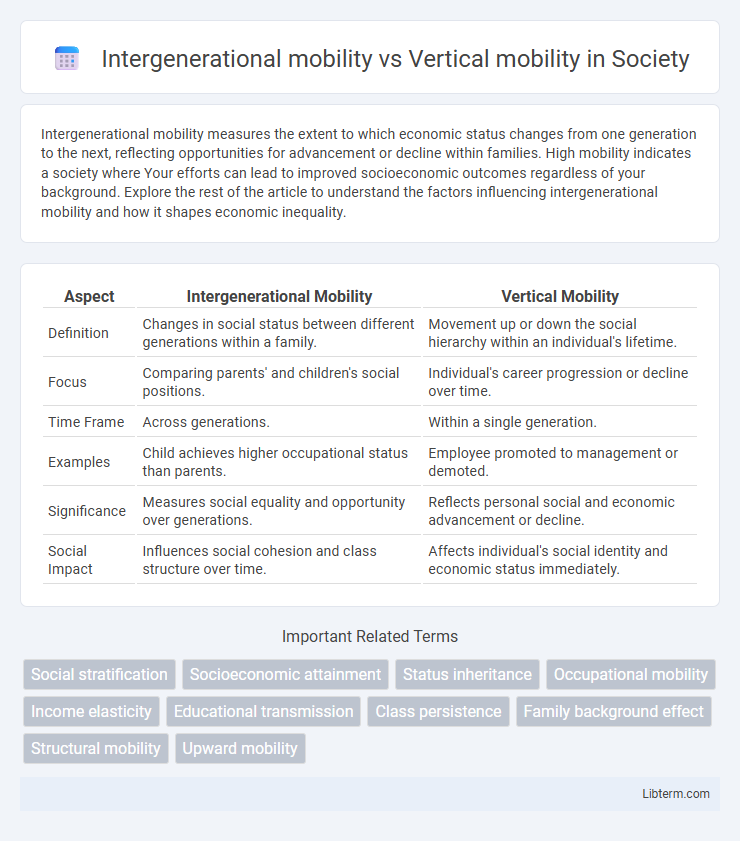Intergenerational mobility measures the extent to which economic status changes from one generation to the next, reflecting opportunities for advancement or decline within families. High mobility indicates a society where Your efforts can lead to improved socioeconomic outcomes regardless of your background. Explore the rest of the article to understand the factors influencing intergenerational mobility and how it shapes economic inequality.
Table of Comparison
| Aspect | Intergenerational Mobility | Vertical Mobility |
|---|---|---|
| Definition | Changes in social status between different generations within a family. | Movement up or down the social hierarchy within an individual's lifetime. |
| Focus | Comparing parents' and children's social positions. | Individual's career progression or decline over time. |
| Time Frame | Across generations. | Within a single generation. |
| Examples | Child achieves higher occupational status than parents. | Employee promoted to management or demoted. |
| Significance | Measures social equality and opportunity over generations. | Reflects personal social and economic advancement or decline. |
| Social Impact | Influences social cohesion and class structure over time. | Affects individual's social identity and economic status immediately. |
Understanding Intergenerational Mobility
Intergenerational mobility measures the extent to which economic status or social class changes from one generation to the next, highlighting long-term social equality and opportunity. This concept contrasts with vertical mobility, which refers to an individual's movement up or down the social hierarchy within their lifetime. Analyzing intergenerational mobility involves assessing the persistence of socioeconomic advantages or disadvantages across familial lines, using metrics like income elasticity and occupational status correlation.
Defining Vertical Mobility
Vertical mobility refers to the movement of individuals or groups up or down the social hierarchy, often measured through changes in socioeconomic status, occupation, or income within a person's lifetime. Unlike intergenerational mobility, which compares social status across generations, vertical mobility emphasizes the personal advancement or decline in social class. Indicators of vertical mobility include promotions, demotions, or significant shifts in education and income levels that alter one's social standing.
Key Differences Between Intergenerational and Vertical Mobility
Intergenerational mobility measures the change in social status or class from one generation to the next within a family, highlighting shifts in wealth, education, or occupation over time. Vertical mobility refers to an individual's movement up or down the social hierarchy during their lifetime, emphasizing personal social advancement or decline. The key difference lies in temporality and scope: intergenerational mobility assesses social changes across generations, whereas vertical mobility focuses on an individual's upward or downward movement within a single generation.
Historical Perspectives on Social Mobility
Intergenerational mobility examines changes in social status across generations within families, highlighting how historical contexts influence opportunities for upward or downward movement. Vertical mobility refers to an individual's or group's shift in social hierarchy within their lifetime, often shaped by economic transformations and shifts in labor markets throughout history. Historical perspectives reveal that periods of industrialization and social reform significantly impacted both types of mobility by altering education access and occupational structures.
Factors Influencing Intergenerational Mobility
Intergenerational mobility is influenced by factors such as family background, educational opportunities, social networks, and economic resources, which shape the ability of individuals to move between social classes across generations. In contrast, vertical mobility often depends on changes within a person's lifetime, driven by career advancement, income changes, or educational attainment. Understanding disparities in intergenerational mobility requires examining systemic inequalities, access to quality education, and social capital that either enable or hinder upward movement between generations.
Determinants of Vertical Mobility
Vertical mobility refers to the movement of individuals or groups up or down the social hierarchy, often influenced by factors such as education, occupation, income, and social capital. Determinants of vertical mobility include access to quality education, professional skill acquisition, economic opportunities, and structural factors like labor market conditions and social policies. Unlike intergenerational mobility, which compares social status between generations, vertical mobility emphasizes individual changes within a lifetime shaped by personal achievements and social environments.
Measuring Mobility Across Generations
Intergenerational mobility measures changes in social status from parents to their children, reflecting the long-term potential for socioeconomic advancement across generations. Vertical mobility captures any upward or downward movement within a social hierarchy, often assessed through occupational or income shifts within individuals' lifetimes. Accurate measurement uses indicators like income percentiles, educational attainment, and occupational status to compare generational trajectories and quantify mobility rates.
Social Mobility and Economic Inequality
Intergenerational mobility measures changes in social or economic status between generations within a family, reflecting long-term social mobility trends, whereas vertical mobility involves individual movement up or down the social hierarchy during a lifetime. High intergenerational mobility indicates lower economic inequality, as children have greater chances to surpass their parents' socioeconomic status, while limited mobility entrenches social stratification. Understanding both forms is crucial for analyzing persistent economic disparities and formulating policies aimed at enhancing equitable opportunities across society.
Policy Implications for Mobility Improvement
Intergenerational mobility reflects changes in socioeconomic status across generations, while vertical mobility involves an individual's movement within a social hierarchy, either upward or downward. Effective policies aimed at improving mobility must address educational access, equitable labor markets, and social safety nets to break systemic barriers that hinder both intergenerational and vertical mobility. Targeted interventions such as early childhood education funding, workforce skill development programs, and progressive taxation are critical to fostering equal opportunities and reducing persistent inequality.
Future Trends in Social Mobility
Future trends in social mobility emphasize increasing intergenerational mobility as economic innovations and educational access expand opportunities across family generations. Vertical mobility continues to evolve with shifting labor markets, where career advancements and income changes reflect dynamic social stratification. Technological integration and policy reforms are critical drivers shaping how upward and downward mobility manifest in diverse socioeconomic landscapes.
Intergenerational mobility Infographic

 libterm.com
libterm.com